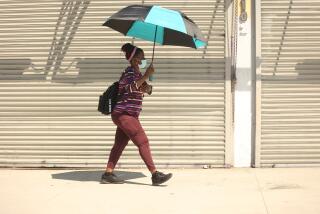Heat’s Effect on Health Studied
- Share via
As the suspected death toll from last week’s heat wave exceeded 160, state and federal officials Wednesday announced a far-reaching study that would look at the impact of extreme heat and global warming on the health of Californians.
A key issue the research will take up is how heat-related illnesses are affected by the development boom in some of the state’s hottest regions, including the Inland Empire and Central Valley.
“Unfortunately, the most population growth is occurring in the hottest areas of the state,” said Paul English, an environmental health investigator for the California Department of Health Services who will oversee the study. “If we continue to see heat waves and increased temperatures, there will be more illnesses and deaths related to that.”
Working with the Centers for Disease Control and Prevention, the state will track deaths and illnesses caused by hot weather and other environmental hazards. Results from the $4.5-million study will be used to establish new policy.
The announcement came after the July heat wave created what officials described as an “invisible natural disaster.” Record temperatures caused the deaths of mostly elderly people and transients who could not or would not seek shelter.
The death toll was greater than other, better-known natural disasters, including the Loma Prieta and Northridge earthquakes.
“The tragic deaths and illnesses during our most recent heat wave exemplify how high temperatures can pose a serious health threat for Californians,” said Dr. Mark Horton, the state’s public health officer, in a news release Wednesday.
Officials said they want to better understand the health effects of the demographic shift away from cooler coastal regions and in hotter inland regions (it can be more than 20 degrees warmer in the Inland valleys than in coastal areas). San Bernardino and Riverside counties are among the fastest-growing areas in the nation, and portions of the Central Valley have become Bay Area suburbs.
Officials are concerned that hospitals and other emergency services in the hotter areas will not be equipped to handle the number of people seeking treatment for heat-related illnesses.
Last month’s heat wave and subsequent casualties gave residents and healthcare workers a glimpse of what could occur in the future. Some counties’ morgues were overrun. State officials are considering classifying heat emergencies at the same level as other natural disasters and developing an emergency plan to respond to its health effects.
More than 160 suspected deaths occurred in California during the heat wave, including 19 each in Fresno and Stanislaus counties and 10 each in Imperial and San Bernardino counties. Most of the hardest hit counties were in the fastest growing regions, including the Inland Empire and the Central Valley.
There were far fewer deaths and illnesses in coastal counties (Los Angeles County has reported two -- one in Lancaster and the other in Boyle Heights).
The trend toward larger houses in the state’s hotter regions has sharply increased the use of power-hungry air conditioning, offsetting more energy-efficient appliances and building design and creating “hot zones,” in which pavement and concrete prevents the earth from cooling off, experts say.
English said health risks also would increase as more greenhouse gas emissions were released into the environment.
Motor vehicle exhaust is one of the largest sources of greenhouse gases, such as carbon dioxide. Those gases increase global warming by trapping sunlight and heat and increase levels of ground-level ozone that can exacerbate illnesses, such as asthma.
California has the largest greenhouse gas emissions of any state in the U.S., emitting about 500 million metric tons annually.
Information from the study also will become part of a national databank on the effects of global warming on public health, English said.
Ozone-related illnesses include respiratory conditions, asthma and heart attacks.
“We’re trying to develop models to see what will occur,” he said. “It’s been difficult to predict with much accuracy where these heat spikes will occur.”
More to Read
Sign up for Essential California
The most important California stories and recommendations in your inbox every morning.
You may occasionally receive promotional content from the Los Angeles Times.










